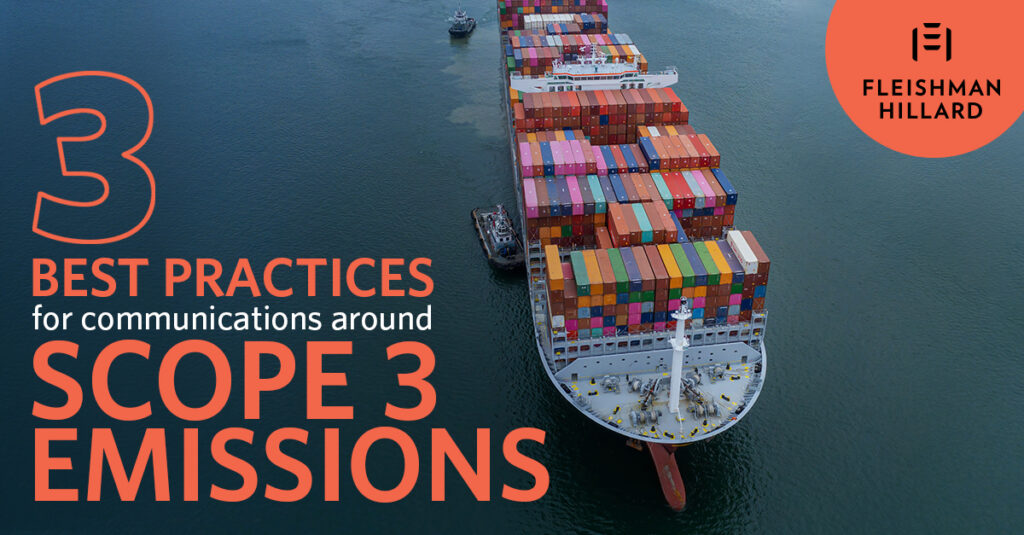Three Best Practices for Communications Around Scope 3 Emissions
This month, the SEC voted to approve new reporting rules that make climate disclosures legally binding. Following this long-anticipated development, sustainability communicators are rightly considering how their own strategies need to evolve. While Scope 1 and 2 emissions are the primary target of the new rules, conversations on the importance of reducing Scope 3 emissions continue to rise at a fast clip.
Scope 3 emissions refer to indirect emissions that occur both upstream and downstream of a company’s value chain. The Science Based Targets initiative (SBTi)— a global collaboration launched by CDP, the United Nations Global Compact, World Resources Institute and WWT in 2015 — considers Scope 3 emissions the “most significant and most challenging source of emissions from businesses.” According to CDP, emissions in a company’s supply chain are on average 11 times higher than direct (Scope 1) emissions and reflect more than 70% of total emissions. Sectors with large, global value chains — including the food and agriculture sector — likely experience the most pressure to decarbonize their supply chains.
Since 2021, Google Trends reports search volume for topics related to Scope 3 emissions has increased by more than 214%, signaling heightened visibility of the importance of reducing emissions throughout the value chain. As the pressure to reduce Scope 3 emissions intensifies, there are three best practices for sustainability communications leaders to leverage.
Transparently Report Out Scope 3 Emissions
Though the new SEC reporting rules lack a mandate for reporting on Scope 3 emissions, regulations in other markets — especially Europe — go much further. Due in part to this global regulatory pressure, disclosing emissions is becoming common place for large companies. To qualify as a science-based target, companies must have a plan to “reduce Scope 1, 2 and 3 emissions to zero or a residual level.” As of this writing, 7,705 companies have started the process of setting a science-based target and 4,778 companies have had their targets approved.
For companies that haven’t taken the step of aligning with SBTi, finding ways to start tracking and reporting out on Scope 3 emissions is a best practice. Scope 3 emissions can be disclosed within sustainability reports and key reductions in emissions should be celebrated in website materials, handouts or even content for LinkedIn.
Focus Media Pitches on Achieving Rather Than Setting Goals
Over two decades ago, psychologists conducted a study designed to assess how people think about the future. Researchers asked participants to consider their activities and available spare time that day and a month from that day, and then decide on which day they’d have more time. This landmark study demonstrated humanity’s tendance toward “delay discounting” wherein we prefer to incur a large cost later, rather than a small cost now.
As 2030 inches closer, the gap between where companies are currently, and the ambition established within their net-zero targets is becoming apparent. In response to the “delay discounting” related to climate targets, many sustainability-focused reporters are giving less airtime to goals announcements and instead prioritizing coverage for companies that meet or exceed targets early. Highlighting key successes and strategies that can be leveraged by other stakeholders to reach net-zero can be a top-tier media-winning strategy.
Collaborate to Proactively Address the Barriers to Decarbonization Within the Value Chain
Disclosing and reducing Scope 3 emissions is challenging because these emissions are not produced by the company themselves. Companies must lean on suppliers and customers to report emissions and track progress. This is particularly challenging for companies like food processors that take in a wide range of inputs to create a food product, and for companies that operate across multiple markets with a patchwork of sustainability regulations. Sharing learnings throughout the value chain and collaborating to increase the accuracy of Scope 3 emissions reporting must become a standard practice. Rather than a “race” to net-zero, we must consider how we can collaborate to get there together.
Though the new norm of reporting out on Scope 3 emissions and diligently working to meet targets set well into the future may be challenging, my colleagues and I remain energized by the opportunity to define solutions for entire value chains to collaborate on decarbonization. By setting transparent goals, working to achieve them and collaborating with sector partners, we can take critical steps on the journey to net zero.
Ericka Loida contributed to this piece.

